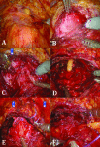Initial Canadian experience with robotic simple prostatectomy: Case series and literature review
- PMID: 26425225
- PMCID: PMC4581929
- DOI: 10.5489/cuaj.2750
Initial Canadian experience with robotic simple prostatectomy: Case series and literature review
Abstract
Introduction: Robotic-assisted simple prostatectomy (RASP) has been touted as an alternative to open simple prostatectomy (OSP) to treat large gland benign prostatic hyperplasia. Our study assesses our institution's experience with RASP and reviews the literature.
Methods: We performed a retrospective chart review from January 2011 to November 2013 of all patients undergoing RASP and OSP. Operative and 90-day outcomes, including operation time, intraoperative blood loss, length of hospital stay (LOS), transfusion requirements, and complication rates, were assessed.
Results: Thirty-two patients were identified: 4 undergoing RASP and 28 undergoing OSP. There was no difference in mean age at surgery (69.3 vs. 75.2 years; p = 0.17), mean Charlson Comorbidity Index (2.5 vs. 3.5; p = 0.19), and mean prostate volume on TRUS (239 vs. 180 mL; p = 0.09) in the robotic and open groups, respectively. There was a significant difference in the mean length of operation, with RASP exceeding OSP (161 vs. 79 min; p = 0.008). The mean intraoperative blood loss was significantly higher in the open group (835.7 vs. 218.8 mL; p = 0.0001). Mean LOS was shorter in the RASP group (2.3 vs. 5.5 days; p = 0.0001). No significant differences were noted in the 90-day transfusion rate (p = 0.13), or overall complication rate at 0% with RASP vs. 57.1% with OSP (p = 0.10).
Conclusions: Our data suggest RASP has a shorter LOS and lower intraoperative volume of blood loss, with the disadvantage of a longer operating time, compared to OSP. It is a feasible technique and deserves further investigation and consideration at Canadian centres performing robotic prostatectomies.
Figures

References
LinkOut - more resources
Full Text Sources
Other Literature Sources
